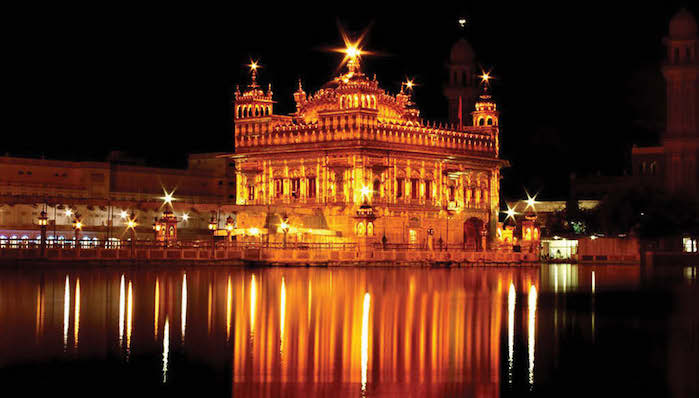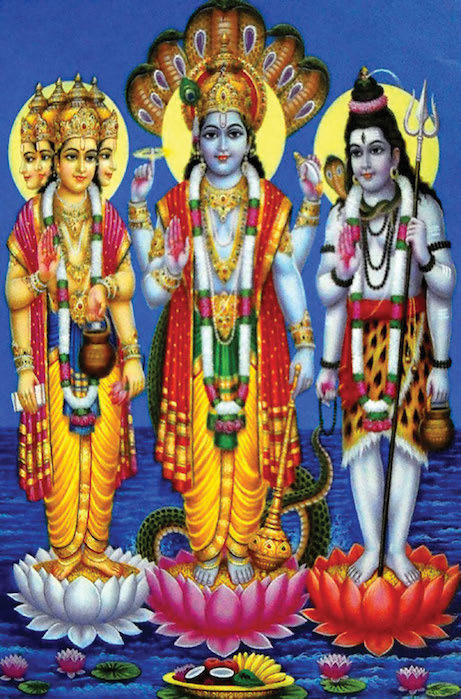
When Brahman is viewed as the supreme personal being (rather than as the infinite principle) Brahman is called Ishvara (“The Lord”;), bhagavan (“The Auspicious One”;), or Parameshwara (“The Supreme Lord”). Ishvara thus refers to the personal aspect of Brahman in general; it is not specific to a particular deity. Ishvara transcends gender, yet can be looked upon as father, mother, friend, child, or even as sweetheart. Some schools of Hindu philosophy do not believe in Ishvara, while others interpret Ishvara in different ways. Some schools do not distinguish between Ishvara and Brahman. The dvaita-advaita school holds that Ishvara is not incorporeal, but is infinite and a personal being.
According to Bhagavata Purana, absolute Brahman can be realized in three ways.
- Brahman it self ( the absolute reality)
- Paramatma (union of all individual souls)
- Bhagavan (as a personal God)
Devatas: The Celestial Beings – The Hindu scriptures also speak about many celestial entities, called devas (“The shining ones”, also called devatas). The word devas may be translated into English as Gods, Deities, Celestial Spirits or Angels. The feminine of deva is devi.
The Vedas and Puranas depict traditional stories about individual devas. The latter lauds the Trimurti of Mahadevas (“Great Gods”), which are the three aspects of God, Brahma, Vishnu and Shiva. Numerous other devas have been worshiped throughout Hinduism’s history. The devas are an integral part of Hindu culture and are depicted in art, architecture and through icons. In their personal religious practices, Hindus worship primarily one or another of these deities, known as their i??a devata, or chosen ideal. The particular form of God worshiped as one’s chosen ideal is a matter of individual preference and needs, influenced by regional and family traditions.
Atman: The Innermost Self
We as individuals are also a part of this changing universe. Our bodies are constantly undergoing change, while our minds, formed of thoughts and feelings, are also in a state of flux. According to Vedanta, however, our self consists of more than mind and body. At its core lies the unchanging atman, our innermost, transcendental Self, as opposed to the material self (our body, thoughts, and feelings) that is part of the universe. The atman is our True Self. But we lose sight of it because of our passionate involvement with our material self and its search for happiness in this universe. The universe can never provide perfect and permanent happiness, however, because it, like our material self, is in a state of constant flux. We attain true happiness only through an awareness of our atman and the discovery of its true relationship with Brahman.
By achieving awareness of atman and its unity with Brahman, we attain not only happiness, but also moksha, or liberation. But liberation from what? At one level, the liberation is from unhappiness, but the answer provided by Vedanta Hinduism goes deeper: Moksha is liberation from a chain of lives called samsara.
Samsara: The Chain of Lives
We normally think of ourselves as coming into being when we are born of our parents and as perishing when we die. According to Hinduism, however, this current life is merely one link in a chain of lives that extends far into the past and projects far into the future. The point of origin of this chain cannot be determined. The process of our involvement in the universe—the chain of births and deaths—is called samsara.
Samsara is caused by a lack of knowledge of atman (our Innermost Self) and our resultant desire for fulfillment outside ourselves. We continue to embody ourselves, or be reborn, in this infinite and eternal universe as a result of these unfulfilled desires. The chain of births lets us resume the pursuit. The law that governs samsara is called karma. Each birth and death we undergo is determined by the balance sheet of our karma—that is, in accordance with the actions performed and the dispositions acquired in the past.
This cycle of action, reaction, birth, death, and rebirth is a continuum called samsara. The Bhagavad Gita states that:
As a person puts on new clothes and discards old and torn clothes, similarly an embodied atman (our Innermost Self) enters new material bodies, leaving the old bodies.
Karma: Action and Its Consequences
Karma is a crucial Hindu concept. According to the doctrine of karma, our present condition in life is the consequence of the actions of our previous lives. The choices we have made in the past directly affect our condition in this life, and the choices we make today and thereafter will have consequences for our future lives in samsara. An understanding of this interconnection, according to Hindu teachings, can lead an individual toward right choices, deeds, thoughts, and desires, without the need for an external set of commandments.
The principle of karma provides the basic framework for Hindu ethics. The word karma is sometimes translated into English as “destiny,” but karma does not imply the absence of free will or freedom of action that destiny does. Under the doctrine of karma, the ability to make choices remains with the individual.
We are subject to the “law” of karma just as our physical movements on earth are subject to the law of gravitation. But just as the law of gravitation does not take away our freedom to move about, the doctrine of karma does not leave us unfree to act. It merely describes the moral law under which we function, just as the law of gravitation is a physical law governing our being.
When we cause pain or injury, we add to the karmic debt we carry into our future lives. When we give to others in a genuine way, we lighten our karmic load. In the Bhagavad-Gita, an important Hindu text, Krishna states that the best way to be free of debt is by selfless action, or by dedicating every action as an offering to Krishna himself. In addition, human beings can purify themselves of karmic debt through different yogas (disciplines), kriyas (purification processes), and bhakti (devotions).
Purusharthas: Stages or Goals of Life
Classical Hindu thought accepts two main life-long dharmas: Grihastha Dharma and Sannyasin Dharma.
The Grihastha Dharma recognize four goals as noble; these are known as the puru?harthas, and they are:
- kama: Sensual pleasure and enjoyment
- artha: Worldly prosperity and success
- dharma: Following the laws and rule that an individual lives under
- moksha: Liberation from the cycle of samsara
Among these, dharma and moksha play a special role: dharma must dominate an individual’s pursuit of kama and artha while seeing moksha, at the horizon.
The Sannyasin Dharma recognizes, but renounces kama, artha and dharma, focusing entirely on moksha. As described below, the Grihasthi eventually enters this dharma as an eventual stage of life. However, some enter this stage immediately from whichever stage they may be in.
Moksha: Liberation from Samsara
Moksha (Freedom or Liberation) from the cycle of birth and death is the ultimate goal of Hindu religious life. Moksha is called Mukti (freedom) by yogis.
The atman (Innermost Self), in its liberated state, possesses divine qualities such as purity, omnipresence and omnipotence, and is beyond limitations. Within the individual, however, the atman is involved in the working of samsara (the cycle of birth and death in the phenomenal world), thereby subjecting itself to bondage by Law of Karma. Moksha is attainted when the individual becomes liberated from the cycle of birth and death and attains eventual union with the Brahman (Supreme Being).
This union can be achieved through gyana or jnana (True Knowledge), bhakti (devotion), or karma (right work). Purity, self-control, truthfulness, non-violence, and compassion toward all forms of life are the necessary pre-requisites for any spiritual path in Hindu dharma. The Hindu dharma emphasizes the importance of a satguru (True Guru or Spiritual Master) for the attainment of True Knowledge of the atman and Brahman.
Darshanas: Schools of Thought
As Hinduism developed, it did not reject its parent traditions, but modified and assimilated them into newer schools of thought. For example, the ancient Vedic notion of sacrifice, and the later philosophies of Sankhya and Yoga, have all been assimilated into the more recent school of Vedanta. Even the more sectarian sampradaya do not entirely reject other doctrines, but claim that they demonstrate a less complete understanding.
Despite a relatively inclusive approach, Hinduism has rejected those doctrines that do not accept its scriptural authority. Most notably these include Jainism, Buddhism, and the hedonistic philosophy of Charvaka. They are therefore called nastika, differentiating them from the accepted schools termed astika. There are six main astika systems, which are called darshanas (ways of seeing). The various groups and sub-groups within Hinduism usually subscribe to one or more of the six darshanas.
The Six Darshanas
The six darshanas are grouped as three pairs of “sisters.” Each pair consists of one darshan dealing with theory and the other explaining the corresponding practice and methodology. For example, Sankhya forms the doctrinal basis for the discipline of yoga. Each pair is further explored in this section.
Some groups consider these schools to be hierarchical, with Vedanta the culmination of Vedic philosophy. This is somewhat supported by the fact that Vedanta means “the end of the Vedas” or, less literally, “the ultimate conclusion of knowledge.” Certainly, Vedanta today represents the more theologically developed strands of Hinduism, and forms the basis for many modern theistic traditions.





Be the first to comment